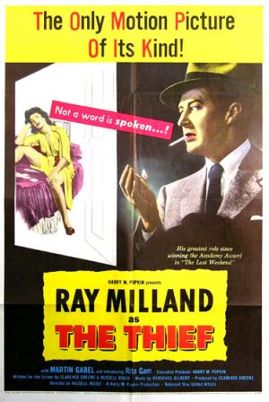
THE THIEF
US, 1952, 86 minutes, Black and white.
Ray Milland, Martin Gabel, Rita Gam.
Directed by Russell Rouse.
The Thief was an experiment in 1952. Only 25 years after The Jazz Singer, here was a film which had no dialogue at all. It did have sound effects, phones ringing, screams… And it had an atmospheric musical score to highlight moods and tensions. However, the film relied on the performance of Ray Milland who communicated his interior states of mind, imagination and fear by his body language and facial expressions. It is a very interesting performance, worth study.
The film was not popular at the box office, too demanding for an audience which had become used to dialogue. The theme was topical for the early 1950s, the anti-Communist feeling, The House of Un- American Activities hearings, the beginning of the Mc Carthy era.
Ray Milland portrays a nuclear scientist who has been honoured for his work. But, without any explanation given, we see that he is being controlled by agents, presumably Russian sympathisers, especially Martin Gabel, and the chain of passing on photographic information. The scientist does his own work, but photographs documents and gives them to the contacts.
The dramatic key to the film is that one in the chain has an accident, his camera is discovered, the FBI come in for investigation, the scientist is followed – as he changes apartments, gets a false passport, is due to ship out to Cairo. There is quite a climax in the Empire State Building, the scientist moving towards the roof, an FBI agent in pursuit.
Of interest, the film introduces Rita Gam. She has quite a small role but a striking visual one.
The film was co-written by producer Clarence Greene and director Russell Rouse.
1. Atmosphere of Atomic Research, Nuclear Espionage in the 1940s and 1950s? Communist Fears?
2. An experimental film, absence of dialogue, focus on action, the sounds, especially the phone? The musical score and its contribution to atmosphere and tension?
3. Ray Milland’s performance, his ability to communicate without words, action and exterior behaviour, the suggestion of the interiors, waiting, listening? His scientific work? The illegal photographs? His body language?
4. The contact, in the street, dropping the paper, the phone calls? The several times that he did this?
5. The process of passing on the photos, the chain of people, their activities? Alan Field and his putting the photos in a safe place, in the library? The various people and their responses?
6. Fields and his worries, more photos, his hiding in the room of the Professor, leaving the camera on the desk? Recovering it?
7. At home, his torment?
8. The accident, the consequences? For Field? For the ring?
9. The FBI, getting the camera, the examination of the photos, the arrest of the wrong scientist? Field watching?
10. Field, the information about the key, going to the station, recovering the case, the clothes?
11. Going to the new apartment, the girl and her sexy look, provocative? His watching?
12. The FBI, following, field avoiding them?
13. The message to go to the Empire State Building? The tourist deck? His being followed, going through the door and up the steps, the dangers, at the top? The agent following, falling, his death? The effect on field?
14. The return to the apartment, the relief, preparing to go to the wharf, changing his clothes?
15. Night, the ship, his watching, thinking, deciding to leave and going to the FBI?
16. How successful a cinema experiment, the relying on the techniques of silent film without captions?
17. The 50s, the Cold War, attitudes towards the Soviet Union? The actual spies from this period and their later being sentenced?